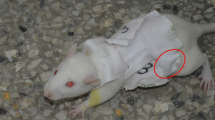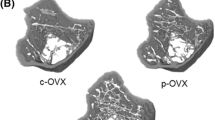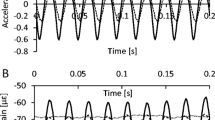Abstract
Low-magnitude, high-frequency vibration (LMHFV) with rest days (particularly seven rest days) was considerably effective in improving the morphological and mechanical properties of rat proximal femur. However, current knowledge is limited regarding the possible benefit of this mechanical regimen to other bone sites and whether the optimal rest days are the same. This study followed our previous experiment on LMHFV loading with rest days for three-month-old male Wistar rats. The experiment involved seven groups, namely, vibrational loading for X day followed with X day rest (X=1, 3, 5, 7), daily vibrational loading, tail suspension and baseline control. Micro-computed tomography (micro-CT) scanning was used to evaluate the microarchitecture of the distal femoral trabecular bone. Micro-CT image-based microfinite element analysis was performed for each distal femoral metaphysis. LMHFV with rest days substantially changed the trabecular arrangement from remarkably plate-like to rod-like. Vibrational loading with 1 day rest was substantially effective in improving the architecture and apparent- and tissuelevel mechanical properties of the rat distal femoral metaphysis. This study may provide an improved understanding of the sitespecific responses of bone tissue to LMHFV with rest days for a substantially effective therapy of a targeted bone site.
Similar content being viewed by others
References
Brennan, M.A., Gleeson, J.P., O'Brien, F.J., and McNamara, L.M. (2014). Effects of ageing, prolonged estrogen deficiency and zoledronate on bone tissue mineral distribution. J Mech Behav Biomed Mater 29, 161–170.
Coughlin, T.R., and Niebur, G.L. (2012). Fluid shear stress in trabecular bone marrow due to low-magnitude high-frequency vibration. J Bio-Mech 45, 2222–2229.
Dempster, D.W., Compston, J.E., Drezner, M.K., Glorieux, F.H., Kanis, J. A., Malluche, H., Meunier, P.J., Ott, S.M., Recker, R.R., and Parfitt, A. M. (2013). Standardized nomenclature, symbols, and units for bone histomorphometry: a 2012 update of the report of the ASBMR Histomorphometry Nomenclature Committee. J Bone Miner Res 28, 2–17.
Gao, J., Gong, H., Huang, X., Zhang, R., Ma, R., and Zhu, D. (2016). Multi-level assessment of fracture calluses in rats subjected to lowmagnitude high-frequency vibration with different rest periods. Ann Biomed Eng 44, 2489–2504.
Gong, H., Zhang, M., Yeung, H.Y., and Qin, L. (2005). Regional variations in microstructural properties of vertebral trabeculae with aging. J Bone Miner Metab 23, 174–180.
Gong, H., Zhang, M., Fan, Y., Kwok, W.L., and Leung, P.C. (2012). Relationships between femoral strength evaluated by nonlinear finite element analysis and BMD, material distribution and geometric morphology. Ann Biomed Eng 40, 1575–1585.
Hildebrand, T., and Rüegsegger, P. (1997). Quantification of bone microarchitecture with the structure model index. Comput Methods Biomech Biomed Eng 1, 15–23.
Homminga, J., McCreadie, B.R., Ciarelli, T.E., Weinans, H., Goldstein, S. A., and Huiskes, R. (2002). Cancellous bone mechanical properties from normals and patients with hip fractures differ on the structure level, not on the bone hard tissue level. Bone 30, 759–764.
Judex, S., Koh, T.J., and Xie, L. (2015). Modulation of bone’s sensitivity to low-intensity vibrations by acceleration magnitude, vibration duration, and number of bouts. Osteoporos Int 26, 1417–1428.
Liang, Y.Q., Qi, M.C., Xu, J., Xu, J., Liu, H.W., Dong, W., Li, J.Y., and Hu, M. (2014). Low-magnitude high-frequency loading, by whole-body vibration, accelerates early implant osseointegration in ovariectomized rats. Mol Med Rep 10, 2835–2842.
Lü, L., Meng, G., Gong, H., Zhu, D., Gao, J., and Fan, Y. (2015). Tissue level microstructure and mechanical properties of the femoral head in the proximal femur of fracture patients. Acta Mech Sin 31, 259–267.
Ma, R., Zhu, D., Gong, H., Gu, G., Huang, X., Gao, J., and Zhang, X. (2012). High-frequency and low-magnitude whole body vibration with rest days is more effective in improving skeletal micro-morphology and biomechanical properties in ovariectomised rodents. HIP Int 22, 218–226.
Mullins, L.P., Bruzzi, M.S., and McHugh, P.E. (2009). Calibration of a constitutive model for the post-yield behaviour of cortical bone. J Mech Behav Biomed Mater 2, 460–470.
Olivares, A.L., Marsal, E., Planell, J.A., and Lacroix, D. (2009). Finite element study of scaffold architecture design and culture conditions for tissue engineering. Biomaterials 30, 6142–6149.
Ozcivici, E., Garman, R., and Judex, S. (2007). High-frequency oscillatory motions enhance the simulated mechanical properties of non-weight bearing trabecular bone. J Biomech 40, 3404–3411.
Ozcivici, E., and Judex, S. (2014). Trabecular bone recovers from mechanical unloading primarily by restoring its mechanical function rather than its morphology. Bone 67, 122–129.
Pasqualini, M., Lavet, C., Elbadaoui, M., Vanden-Bossche, A., Laroche, N., Gnyubkin, V., and Vico, L. (2013). Skeletal site-specific effects of whole body vibration in mature rats: from deleterious to beneficial frequency-dependent effects. Bone 55, 69–77.
Reyes, M.L., Hernández, M., Holmgren, L.J., Sanhueza, E., and Escobar, R.G. (2011). High-frequency, low-intensity vibrations increase bone mass and muscle strength in upper limbs, improving autonomy in disabled children. J Bone Miner Res 26, 1759–1766.
Robling, A.G., Burr, D.B., and Turner, C.H. (2001). Recovery periods restore mechanosensitivity to dynamically loaded bone. J Exp Biol 204, 3389–3399.
Robling, A.G., Hinant, F.M., Burr, D.B., and Turner, C.H. (2002). Improved bone structure and strength after long-term mechanical loading is greatest if loading is separated into short bouts. J Bone Miner Res 17, 1545–1554.
Rubin, C., Recker, R., Cullen, D., Ryaby, J., McCabe, J., and McLeod, K. (2004). Prevention of postmenopausal bone loss by a low-magnitude, high-frequency mechanical stimuli: a clinical trial assessing compliance, efficacy, and safety. J Bone Miner Res 19, 343–351.
Sen, B., Xie, Z., Case, N., Styner, M., Rubin, C.T., and Rubin, J. (2011). Mechanical signal influence on mesenchymal stem cell fate is enhanced by incorporation of refractory periods into the loading regimen. J Biomech 44, 593–599.
Srinivasan, S., Weimer, D.A., Agans, S.C., Bain, S.D., and Gross, T.S. (2002). Low-magnitude mechanical loading becomes osteogenic when rest is inserted between each load cycle. J Bone Miner Res 17, 1613–1620.
Tao, Z.S., Zhou, W.S., Tu, K., Huang, Z.L., Zhou, Q., Sun, T., Lv, Y.X., Cui, W., and Yang, L. (2015). Effect exerted by teriparatide upon repair function of β-tricalcium phosphate to ovariectomised rat’s femoral metaphysis defect caused by osteoporosis. Injury 46, 2134–2141.
Van Rietbergen, B., Huiskes, R., Eckstein, F., and Rüegsegger, P. (2003). Trabecular bone tissue strains in the healthy and osteoporotic human femur. J Bone Miner Res 18, 1781–1788.
Wehrle, E., Liedert, A., Heilmann, A., Wehner, T., Bindl, R., Fischer, L., Haffner-Luntzer, M., Jakob, F., Schinke, T., Amling, M., et al. (2015). The impact of low-magnitude high-frequency vibration on fracture healing is profoundly influenced by the oestrogen status in mice. Dis Model Mech 8, 93–104.
Willinghamm, M.D., Brodt, M.D., Lee, K.L., Stephens, A.L., Ye, J., and Silva, M.J. (2010). Age-related changes in bone structure and strength in female and male BALB/c mice. Calcif Tissue Int 86, 470–483.
Yang, L., Gong, H., and Zhang, M. (2012). Transmissibility of whole body vibration stimuli through human body in different standing postures. J Mech Med Biol 12, 1250047.
Yang, X., Muthukumaran, P., DasDe, S., Teoh, S.H., Choi, H., Lim, S.K., and Lee, T. (2013). Positive alterations of viscoelastic and geometric properties in ovariectomized rat femurs with concurrent administration of ibandronate and PTH. Bone 52, 308–317.
Zhang, R., Gong, H., Zhu, D., Gao, J., Fang, J., and Fan, Y. (2014). Seven day insertion rest in whole body vibration improves multi-level bone quality in tail suspension rats. PLoS ONE 9, e92312.
Zhang, R., Gong, H., Zhu, D., Ma, R., Fang, J., and Fan, Y. (2015). Multilevel femoral morphology and mechanical properties of rats of different ages. Bone 76, 76–87.
Zhang, X., and Gong, H. (2015). Simulation on tissue differentiations for different architecture designs in bone tissue engineering scaffold based on cellular structure model. J Mech Med Biol 15, 1550028.
Acknowledgements
This work was supported by the National Natural Science Foundation of China (81471753, 11432016, 11322223) and the Science and Technology Development Plan Projects of Jilin province (20160101297JC, 20170519008JH, 20170520093JH).
Author information
Authors and Affiliations
Corresponding author
Rights and permissions
About this article
Cite this article
Gong, H., Zhang, R., Gao, J. et al. Whole body vibration with rest days could improve bone quality of distal femoral metaphysis by regulating trabecular arrangement. Sci. China Life Sci. 62, 95–103 (2019). https://doi.org/10.1007/s11427-017-9253-x
Received:
Accepted:
Published:
Issue Date:
DOI: https://doi.org/10.1007/s11427-017-9253-x




